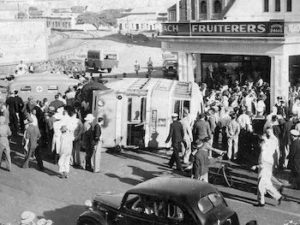
*The Durban riots began on this date in 1949. This was a three-day anti-Indian riot between Black South Africans and South African Indians. The riots, the second deadliest massacre during Apartheid, occurred in Durban, South Africa.
On the evening of January 13, the riots began at Victoria Street in the middle of the Indian commercial center. Black Africans assaulted ethnic Indians in the center of the Indian business area of Durban. The assailants attacked individual Indians, stoning vehicles driven by Indians and looting Indian stores while chanting "Usuthu!". The violence, destruction of property, and looting were subdued after a few hours of rioting. An account by a police detective present at the riots states that there was an organized element to the riots within the Zulu community.
On Friday, African leaders from Cato Manor organized rioters from workers' hostels and social networks, dancing troupes, and boxing clubs. Taking advantage of the slow police intervention, the assailants attacked the Indian business area. Many reports suggest that European whites cheered the African assailants and looted Indian stores. By early evening the government troops blockaded the Indian district in central Durban, after which the focus of assaults shifted to the suburban areas of Cato Manor, Clairwood, and the Jacobs area, where murder, arson, rape, and brutal attacks and looting took place.
An article in the Indian Opinion recounted the devastation: "Huddled under the flames of one of the burning shops were four Indian women and a dozen weeping children. The male owner was in a grotesque attitude on the front path, knifed in several places and dying. A younger [Indian] son staggered in the road with his head split open. This was one of the hundreds of pathetic sites that were witnessed in Cato and other districts of Durban." Friday night saw the peak of the violence when Africans hurled paraffin tins into Indian-owned buildings, and entire Indian families were burned to ashes alive.
By Saturday, the military and police were able to establish order, although limited violence occurred in Pietermaritzburg a few days later. The riots resulted in the massacre of most Indians, in which 142 people died and 1087 were injured. Three hundred buildings were lost, and 2000 structures were damaged. It also created 40,000 Indian refugees, followed by a wave of suicides among Indians because of the disintegration of their families, economic failure, stress, humiliation, and racist discrimination.